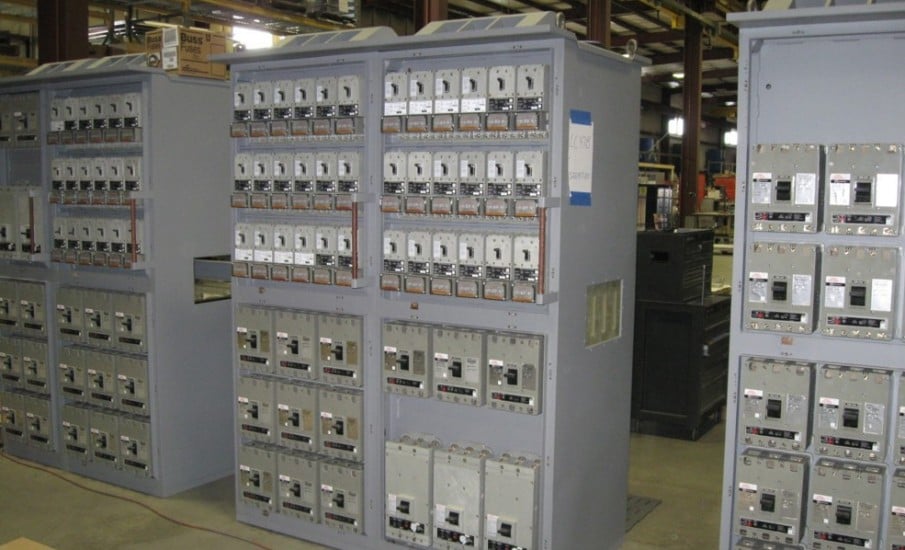The Complex World of Defense Industry Electrical Enclosures

At first glance, a large electrical enclosure might look like a plain metal box. However, the processes and welding techniques required to produce the end result are far from simple.
The types of fabricated electrical enclosures used on naval vessels for the United States Department of Defense (DOD) differ vastly from those produced for common commercial applications. Military metal fabrication specifications call for extremely tight tolerances, dedicated materials and finishes, and rigorous destructive testing to ensure they will withstand the harsh conditions found at sea and in combat.
A metal fabrication company that provides products to the DOD must have proven and documented processes to meet those requirements. As part of those processes, they need to take into account the following challenges and complexities.
Proper Materials and Welding Techniques
Some smaller electrical enclosures may use a combination of steel and stainless steel. However, most large DOD electrical enclosures are constructed of aluminum because of its lighter weight, or a combination of metals.
While there are many benefits to using aluminum, it requires more craftsmanship on the part of welders and fabricators. In short, aluminum is more difficult to weld than stainless steel or other metals, requiring much higher heat inputs during welding and an in-depth understanding of how the material responds and which filler metals and shielding gas to use.
The materials used for DOD enclosures are also a heavier gauge, typically ½-inch or ¾-inch aluminum plate or structural steel. Some electrical enclosures can be 8-feet tall and as large as 10-feet wide by 4-feet deep, necessitating the need for riggers and cranes to move them from one phase of production to the next. Despite aluminum’s inherent lighter weight, it’s not uncommon for an electrical enclosure to weigh 3,000 pounds or more because of its size and features.
NAVSEA and/or AWS Requirements
Many DOD metal fabrication projects are governed by NAVSEA (Naval Sea Systems Command) requirements which dictate welding processes for the U.S. Navy’s fleet of ships, submarines, and combat vessels.
A metal fabrication company must provide documentation that its welders are NAVSEA certified and are capable of conducting the work. Certification requires extensive training, testing, and auditing, which can take months to complete.
As noted, the materials can be more complex for military projects, but so can the sourcing of those materials. Because of their critical nature, most NAVSEA applications do not allow for commodity materials sourced from other countries; materials must be from a domestic supplier or from an allied country with documentation to prove it.
Not all DOD electrical enclosures specify NAVSEA requirements, however. Some use AWS (American Welding Society) standards which differ and have their own training and testing protocols. In other words, a metal fabrication company will need to be certified in both to fulfill most DOD compliance requirements.
Tight Tolerances and Weld Shrinkage
The design specifications for various elements of a DOD electrical enclosure — shelving, brackets, walls, venting, access holes, etc. — have extremely tight tolerances. For example, the Geometric Dimensioning and Tolerancing (GDT) on a drawing might indicate that a fabricated component’s tolerance must be within plus or minus 10 thousandths of an inch (.010”).
Achieving that strict tolerance on a large-scale enclosure is difficult enough, but when you add in the fact that materials typically shrink, twist, and warp when welded, the challenge grows. Aluminum and steel will shrink at different rates while some materials might not shrink at all. The larger the enclosure, the more welding is required and, the more welding, the more shrinkage and twisting. Weldments can move so much that larger components typically require jigs, fixtures, and spot welds to hold them in place and keep them square during different phases of manufacturing.
The propensity for weld shrinkage requires metal fabrication engineers to deploy Design for Manufacturability (DfM) as part of their process. Experienced welders and fabricators know how materials will react and perform under various conditions so that they can adapt.
A simple example is determining the precise location of a hole on an enclosure panel. The GDT on a customer’s CAD drawing might specify the hole location perfectly, but if those holes are machined prior to welding and the panel shrinks, their location will no longer be within acceptable tolerances. Instead, it’s best to machine the hole in its precise location once the enclosure is completed.
An experienced metal fabrication engineer will know that they need to design a second set of CAD drawings for their welders and machinists with slightly larger dimensions that allow for shrinkage and show that the holes need to be machined after assembly.
It can take dozens of individual pieces to fabricate a large electrical enclosure, each requiring separate calculations and measurements based on their size and placement.
It’s like putting together a puzzle where the pieces keep changing.
It’s one thing to design a box; how you get to the final product is the difficult part that requires a proven manufacturing process and in-depth knowledge of the necessary materials and techniques.
Many of the considerations shared in this article need to be included as part of the RFQ process when vetting a metal fabrication company’s ability to perform the work. Download our complimentary Metal Fabrication RFQ Guide — A Checklist of Commonly Overlooked Specifications below to ensure you cover all the bases.
